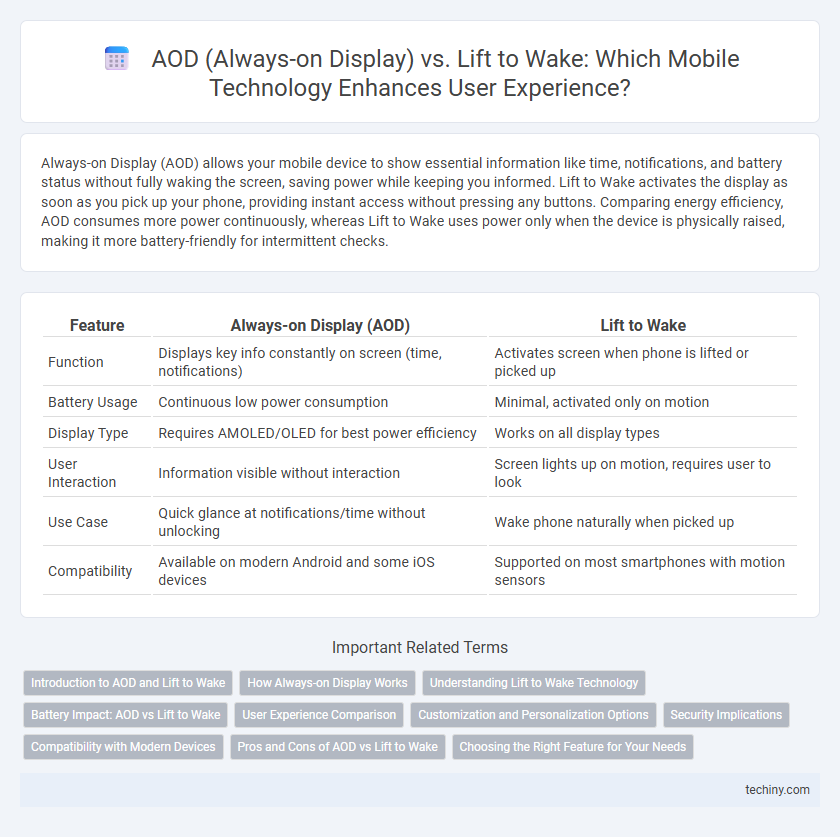Always-on Display (AOD) allows your mobile device to show essential information like time, notifications, and battery status without fully waking the screen, saving power while keeping you informed. Lift to Wake activates the display as soon as you pick up your phone, providing instant access without pressing any buttons. Comparing energy efficiency, AOD consumes more power continuously, whereas Lift to Wake uses power only when the device is physically raised, making it more battery-friendly for intermittent checks.
Table of Comparison
| Feature | Always-on Display (AOD) | Lift to Wake |
|---|---|---|
| Function | Displays key info constantly on screen (time, notifications) | Activates screen when phone is lifted or picked up |
| Battery Usage | Continuous low power consumption | Minimal, activated only on motion |
| Display Type | Requires AMOLED/OLED for best power efficiency | Works on all display types |
| User Interaction | Information visible without interaction | Screen lights up on motion, requires user to look |
| Use Case | Quick glance at notifications/time without unlocking | Wake phone naturally when picked up |
| Compatibility | Available on modern Android and some iOS devices | Supported on most smartphones with motion sensors |
Introduction to AOD and Lift to Wake
Always-on Display (AOD) technology enables smartphones to show essential information like time, notifications, and battery status on the screen without fully waking the device, thus conserving battery life while maintaining user accessibility. Lift to Wake uses sensors to detect when the device is raised, automatically activating the screen for quick interaction without pressing any buttons. Both features enhance user convenience by providing immediate access to key information, but AOD maintains a constant low-power display while Lift to Wake activates the screen only upon motion detection.
How Always-on Display Works
Always-on Display (AOD) continuously lights up a portion of a smartphone screen to show essential information like time, notifications, and battery status without fully activating the device. Utilizing AMOLED technology, AOD selectively illuminates pixels, thereby minimizing power consumption while maintaining screen visibility. This energy-efficient mechanism allows users to glance at critical data without pressing buttons or lifting the phone.
Understanding Lift to Wake Technology
Lift to Wake technology activates the smartphone screen automatically when the device is picked up, utilizing built-in accelerometers and proximity sensors. This feature conserves battery life compared to Always-on Display (AOD) by keeping the screen off until motion is detected. Lift to Wake enhances user experience with immediate access to notifications and lock screen information without constant power drain.
Battery Impact: AOD vs Lift to Wake
Always-on Display (AOD) consumes more battery by continuously lighting pixels to show time, notifications, or widgets, even when the phone is locked. Lift to Wake activates the screen only when the device is lifted, resulting in lower battery drain compared to AOD since the display remains off most of the time. Choosing Lift to Wake over AOD can significantly extend battery life on smartphones with OLED or AMOLED screens due to reduced power usage during idle periods.
User Experience Comparison
Always-on Display (AOD) offers continuous visibility of time, notifications, and essential information without unlocking the phone, enhancing convenience and reducing interaction time. Lift to Wake activates the screen only when the device is lifted, saving battery life while providing quick access but requiring a deliberate motion to check updates. AOD excels in passive information delivery, whereas Lift to Wake balances energy efficiency with user-triggered screen activation for a more interactive experience.
Customization and Personalization Options
Always-on Display (AOD) offers extensive customization options, allowing users to personalize clock styles, notifications, and background images without unlocking the device. Lift to Wake provides a more limited, automatic activation experience focused on convenience rather than detailed personalization. AOD's flexibility enhances user engagement by enabling constant access to tailored information, while Lift to Wake emphasizes quick, gesture-based interaction.
Security Implications
Always-on Display (AOD) continuously shows information on the screen, increasing the risk of unauthorized data exposure through shoulder surfing or visual hacking. Lift to Wake activates the screen only when the device is lifted, reducing the window of opportunity for attackers to view sensitive notifications or content. Mobile security is enhanced by minimizing passive screen exposure, making Lift to Wake a preferable choice for safeguarding personal information in public spaces.
Compatibility with Modern Devices
Always-on Display (AOD) is widely compatible with modern AMOLED screens, leveraging individual pixel illumination for efficient power use, while Lift to Wake relies on accelerometer sensors integrated into newer smartphones, offering seamless wake functionality. AOD supports custom notifications and clock displays without unlocking the device, enhancing user experience on flagship models from brands like Samsung and Google Pixel. Lift to Wake is typically found in devices with advanced motion detection capabilities, such as recent iPhones and OnePlus phones, providing quick access without draining battery significantly.
Pros and Cons of AOD vs Lift to Wake
Always-on Display (AOD) offers continuous visibility of key information like time, notifications, and battery status without waking the screen, resulting in increased convenience but higher battery consumption. Lift to Wake activates the screen only when the device is lifted, conserving battery life more effectively but sometimes causing missed notifications if the motion sensor fails. Choosing between AOD and Lift to Wake depends on prioritizing either constant accessibility or optimized power efficiency in mobile devices.
Choosing the Right Feature for Your Needs
Choosing between Always-on Display (AOD) and Lift to Wake depends on your usage patterns and battery preferences; AOD continuously shows essential information without unlocking the phone, ideal for users who need quick glances at time and notifications. Lift to Wake activates the screen only when the device is picked up, conserving battery life and providing a more power-efficient option for intermittent checking. Evaluating your need for constant visibility versus battery optimization will help determine the optimal feature for your mobile experience.
AOD (Always-on Display) vs Lift to Wake Infographic

 techiny.com
techiny.com